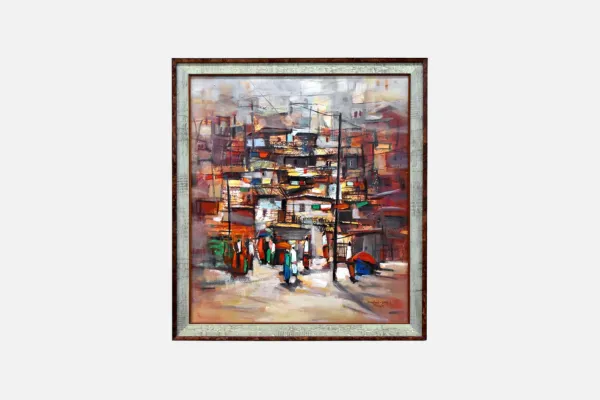
The Importance of Conservation Framing for Artwork in Denver
The Importance of Conservation Framing for Artwork in Denver
Denver’s sunlight is brilliant, something locals love, but artwork does not. Paintings, photographs, and prints exposed to harsh light or dry mountain air can fade, yellow, or warp over time. For anyone who treasures art, whether a collector, artist, or homeowner, conservation framing isn’t a luxury, it’s essential preservation. It’s the science and craftsmanship behind keeping your artwork as vibrant tomorrow as the day it was created.
Understanding the Concept of Conservation Framing
Conservation framing, sometimes called archival or museum framing, goes beyond simple aesthetics. It’s about protecting the integrity of the piece. Every material used, glass, mat board, tape, backing,is carefully selected to prevent chemical or physical harm to the artwork.
In traditional framing, inexpensive mats or adhesives often contain acids and lignin, substances that gradually eat into paper fibers and pigments. Over time, that damage becomes visible as browning, staining, or brittleness. Conservation framing replaces these with acid-free and pH-neutral materials that maintain stability for decades.
At AUM Framing & Gallery, our process always begins with evaluation. We consider the medium (paper, canvas, textile), the condition, and the display environment. A work on paper, for example, requires a different mounting system than a stretched canvas or textile. The goal is the same in every case: total protection, minimal interference.
Why Denver’s Climate Makes Conservation Framing Essential
Denver’s climate is unique, low humidity, wide temperature swings, and abundant sunshine at high altitude. These elements combine to create ideal living conditions for people, but challenging ones for art.
Low humidity can cause natural materials like wood and canvas to contract, while sudden temperature changes expand and contract the fibers. Over time, this can cause cracking, stretching, or delamination of layers.
The high UV index at altitude intensifies sunlight exposure, accelerating color fading and weakening paper or varnish. For this reason, UV-protective glazing, either museum glass or UV-filtering acrylic, is critical for Denver art owners. These glazing options filter up to 99% of harmful rays while maintaining optical clarity.
In our Denver workshop, clients often bring in works that have hung near windows for only a few years and already show fading. Conservation framing prevents that irreversible damage.
The Role of Materials and Methods
Every conservation frame is built as a system, with each component contributing to preservation. The glass or acrylic shields the surface; the mat and backing control pH and air flow; the mount ensures reversibility.
Our mat boards are acid-free, lignin-free, and often buffered to neutralize environmental pollutants. The backings are sealed to protect from dust and insects, while tiny spacers maintain airflow to prevent artwork from sticking to the glazing.
Together, these details extend the life of your piece dramatically. Many collectors who bring us older works for re-framing are shocked at how much color and integrity can be preserved once inferior materials are replaced.
Balancing Design and Protection
Conservation doesn’t mean sacrificing beauty. A thoughtfully designed frame enhances both the artwork and the environment it lives in.
The color and texture of the mat, the width of the moulding, and the sheen of the finish all play roles in directing how the viewer experiences the art. Our framers balance aesthetics with archival integrity, ensuring each piece is both protected and visually elevated.
In practice, this often means designing the frame to serve two masters: the art and the space. We frequently work with interior designers and collectors in Denver who want to complement modern or historic interiors while maintaining full conservation standards.
Real Results: A Case from Our Denver Studio
A watercolor landscape came into the gallery several years ago beautifully painted but discolored along the edges, with a faint brown halo where old mats had transferred acid. We removed it from its original frame and re-mounted it with conservation materials. The transformation was immediate: the paper relaxed, the discoloration stopped spreading, and under museum glass, the painting regained its depth and vibrancy.
It’s this kind of restoration-through-framing that demonstrates why the quality of your materials matters as much as the art itself.
Caring for Conservation-Framed Art
Even the best framing requires ongoing mindfulness. Art should never hang in direct sunlight or near heating vents. Regular inspection is key. Look for condensation, dust accumulation, or warping. If anything seems off, bring it in for a quick assessment.
For long-term maintenance, gentle cleaning of the glass and frame surface with a soft, dry cloth is sufficient. Avoid commercial cleaners, as even trace chemicals can damage finishes or seep into seams.
A good conservation frame can last decades with only minor upkeep, making it one of the best long-term investments an art owner can make.
Why Choose AUM Framing & Gallery
As Denver’s trusted destination for custom framing and restoration, AUM Framing & Gallery approaches each project as both craft and preservation. Every piece of art, whether a museum-quality painting or a family photograph, receives the same care and respect.
Our experience with Denver’s climate gives us insight into how art materials behave here, how wood reacts to dryness, how glass performs in bright light, and how humidity fluctuations can affect aging. That local expertise allows us to design frames that not only look right but last beautifully in the region’s conditions.
For artists, collectors, and homeowners alike, conservation framing ensures your artwork remains a living part of your space, not a fading memory behind glass.